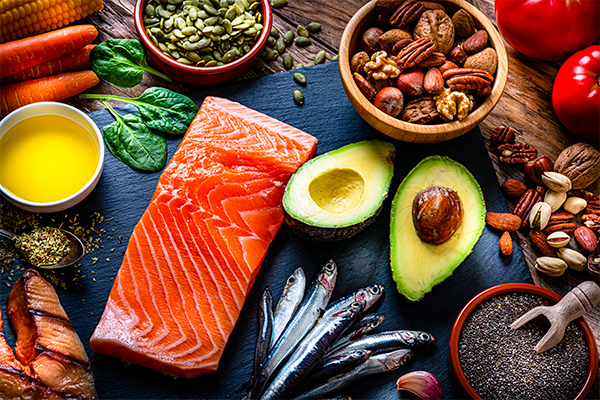[ad_1]
Fat is the enemy — at least that’s what we were told for decades. Low-fat and fat-free foods flew off shelves as people assumed cutting fat from their diets would help them keep off the pounds.
But recent research has shown that low-fat and fat-free foods typically have higher sugar content, and excess sugar consumption has been linked to weight gain as well as an increased risk of type 2 diabetes and cardiovascular issues.
The truth is, we need to eat fat. But that doesn’t mean all high-fat foods are equally healthy. When it comes to sources of dietary fat, there’s a big difference between eating an avocado and eating a plate of greasy fries.
So what exactly are “healthy fats” — and which types of fat should you avoid at all costs? Here’s what you need to know.
Why Is Fat Important in a Balanced Diet?
“Fat is vital for brain and cell function,” says Andrea N. Giancoli, M.P.H., R.D.
Along with protein and carbohydrates, fat is one of the three main macronutrients that our bodies need to thrive. While carbs often get the credit for giving us energy, Giancoli says, “Fat has double the amount of energy of carbs or protein.”
This means that while carbs can give us the initial energy during workouts, fat gives us the extra energy to keep going after 20 minutes or so.
And, registered dietitian Maleah Staton, R.D., C.P.T., adds, “Fat is important because it helps us absorb fat-soluble vitamins like A, D, E, and K.”
Dietary fat also provides the essential fatty acids known as linoleic acid (an omega-6 fatty acid) and alpha-linolenic acid (an omega-3 fatty acid) that our bodies can’t make. These fatty acids have been linked to a reduced risk of heart disease, better brain function, and improved eye health, among other benefits.
Which Types of Fat Are Healthy Fats?
There are four different types of fat found in food:
- Saturated fat
- Monounsaturated fat
- Trans fat
- Polyunsaturated fat
Monounsaturated and polyunsaturated fats get the honor of being deemed “healthy fats” — and, Giancoli says, we need a good balance of these two types of fat in our diets.
Monounsaturated fats
Monounsaturated fats are unsaturated fats that have a single (mono) chemical bond. Studies have shown that replacing a diet high in saturated fat with a diet high in monounsaturated fats can help decrease LDL cholesterol (low-density lipoprotein, aka “bad” cholesterol), and monounsaturated fat has also been linked to lower blood pressure.
Polyunsaturated fats
On the other hand, polyunsaturated fats are made up of multiple (poly) chemical bonds. These types of fat provide our bodies with omega-3 and omega-6, two fatty acids that are essential for health, but not made by the body.
Omega-3 fatty acids have been linked to better heart health and eye health, along with a lower risk of some emotional and cognitive conditions. To get more omega-3s in your diet, the American Heart Association recommends eating fatty fish — like salmon, sardines, tuna, and mackerel — at least twice a week.
Omega-6 fatty acids — commonly found in vegetable oils, nuts, and seeds — are also essential. But research suggests a high-omega-6 diet may be linked to inflammation, and we should aim for a balance of omega-3s and omega-6s.
What Are Less Healthy Fats?
Saturated fats and trans fats are considered the not-so-healthy fats.
Saturated fats
Typically solid at room temperature — think butter and palm oil — saturated fats have been linked to health issues including heart disease from increased LDL cholesterol and weight gain.
Saturated fat is found in animal meats and dairy products, so it’s almost impossible to avoid if you’re an omnivore — but the good news is it’s not necessary to avoid saturated fat completely. Like most things, it’s OK in moderation; the American Heart Association recommends limiting saturated fat to 5 or 6 percent of the total calories you eat every day.
Trans fats
The least healthy of the bunch, there are essentially two types of trans fats: those that come naturally from animals, and artificial trans fats that are manufactured by adding hydrogen to liquid vegetable oils.
Artificial trans fats have no health benefits — they’re known to raise LDL cholesterol, lower HDL cholesterol, and increase your risk of heart disease, stroke, and even type 2 diabetes.
In fact, trans fat poses so much of a risk that partially hydrogenated oils (PHOs) — the primary source of artificial trans fats — have been banned by the FDA. A manufacturing ban on most foods containing PHOs went into effect in 2018, and by 2021, all foods containing PHOs will be removed from the food supply (which makes artificial trans fats easy to avoid).
What Are the Best Healthy Fat Foods?
You should be adding healthy, high-fat foods to your diet. Just be careful, because it’s easy to go overboard, even with unsaturated “healthy” fats.
“It’s important for us to consume fat mindfully, sparingly, and intentionally,” Staton says. Every gram of fat contains nine calories, making it more calorically dense than foods that are high in protein or carbs (each of which contain 4 calories per gram).
Here are some qualifying healthy fat foods:
According to Giancoli, you should get 20 to 35 percent of your daily calories from fat. If you eat 2,000 calories per day, that means 400 to 700 of those calories should come from fat.
[ad_2]
Source link



